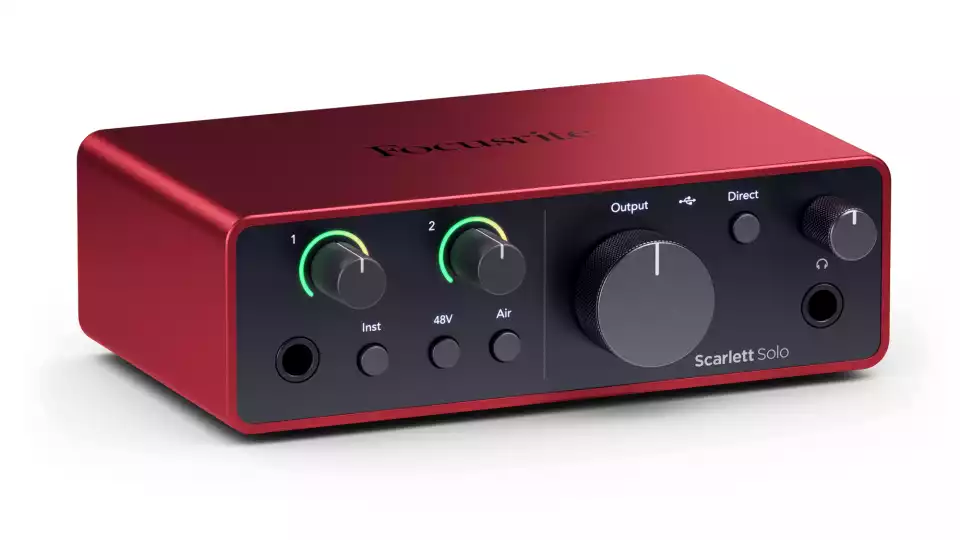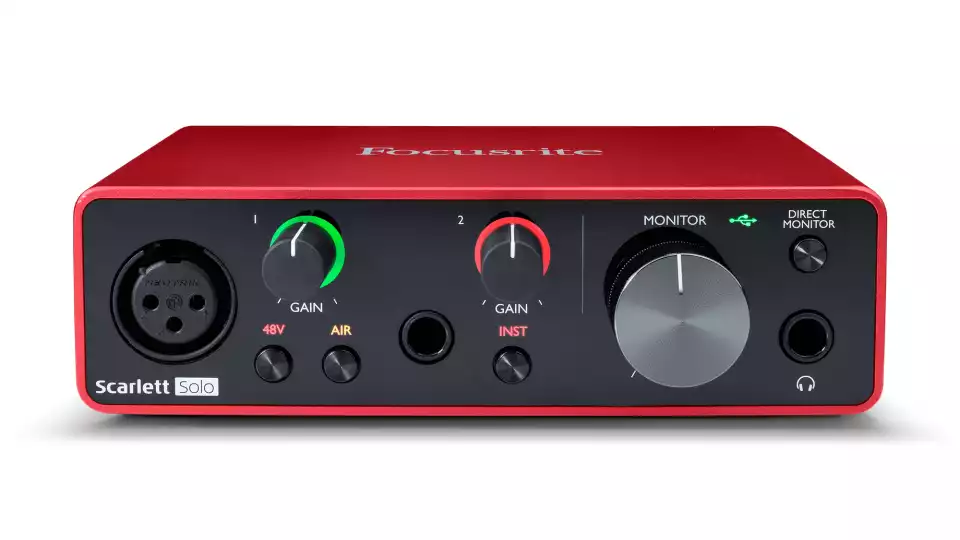Focusrite just recently released their 4th generation of Scarlett interfaces. So you may be wondering if it’s time for an upgrade.
One of the most popular models is the Scarlett Solo. We’re going to compare the two versions and help you decide if the Scarlett Solo 4th Gen is worth it, or if you should stick with the 3rd gen model.
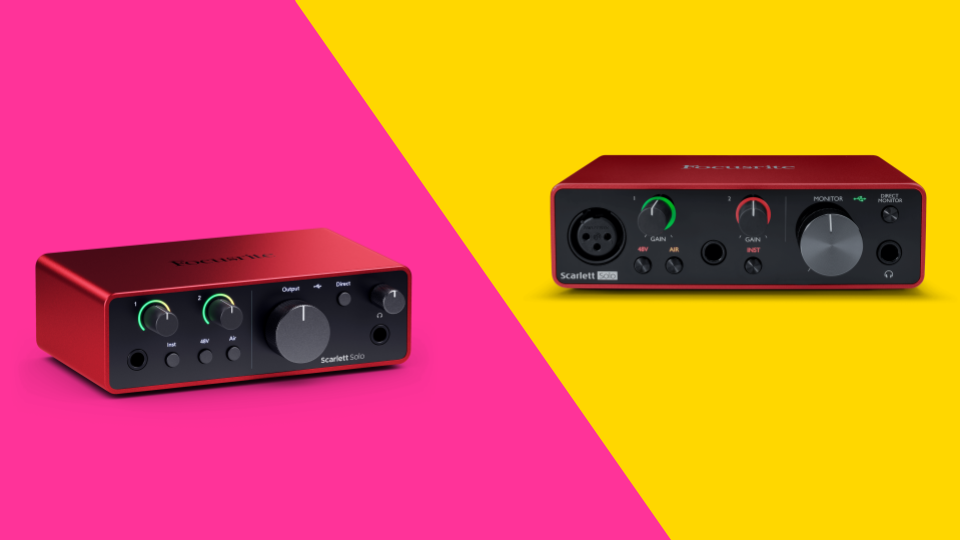
Quick Look: Focusrite Scarlett Solo 4th Gen vs 3rd Gen
Note: This article contains affiliate links. We may earn a commission if you make a purchase, at no additional cost to you.
|
$139.99
|
$123.32
|
|
|
|
|
|
|
- 1 rear-facing XLR input
- 1 front-facing line input
- 2 line outputs
- Connects via USB-C
- 57db gain range for mic preamp
- 57db gain range for line input
- 120db dynamic range for line output
- 115db dynamic range for headphone output
- Direct Monitor offers latency-free monitoring
- Separate volume dials for monitors and headphones
- 2 Air Mode settings — hi-range boost and mid-range boost
- Includes software bundle
- 1 XLR input
- 1 line input
- 2 line outputs
- Connects via USB-C
- 56db gain range for mic preamp
- 56db gain range for line input
- 108db dynamic range for line output
- 108db dynamic range for headphone output
- Direct Monitor offers latency-free monitoring
- 1 Air Mode setting for hi-range boost
- Includes software bundle
Ease of Use
Scarlett audio interfaces are known for their simplicity and ease of use. Thankfully, that’s remained consistent between generations.
You can access all the main controls from the front of either device — no additional software needed.
Inputs & Outputs
Both the 4th and 3rd generation Solo interfaces come with two inputs: 1 XLR input and 1 instrument/line input.
That said, the XLR input has been moved to the rear on the 4th gen model. This has one clear benefit:
Many people keep their interfaces in a permanent spot on their desk — especially streamers. So running an XLR mic through the back can seriously help with cable management.
I can understand the move, but it might be a turn-off for some users who’d still prefer a front-facing XLR port.
However, the line input remains easily accessible on the front side.
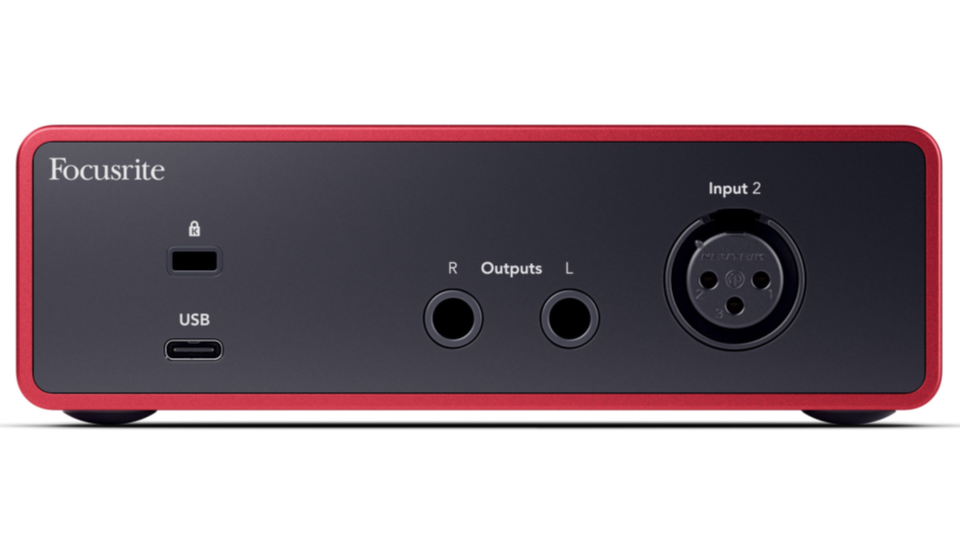
Build Quality
The build quality remains incredibly consistent between the two generations. The 4th generation maintains the iconic brushed-red aluminum chassis.
If you’re repulsed by fingerprints, then you’ll love the Solo 4th gen! The front and back panels now feature a matte black finish, as opposed to the 3rd gen’s glossy plastic finish.
Aside from that, the buttons and dials are all rock solid on both devices. They feel nice to use, and aren’t very wobbly at all.
Audio Quality
Both interfaces can record 24-bit audio at up to 192 kHz. That said, the 4th Gen Scarlett has some major upgrades in regards to sound quality and circuitry.
For starters, the 4th gen Solo now uses Focusrite’s RedNet converters, which are found in their high-end interfaces for pro studios and broadcast stations.
In simple terms, this advanced circuitry produces a cleaner signal from analog to digital. It’ll be less likely to introduce static hiss or any other unwanted noise.
Preamps & Gain Range
The 4th gen Solo has a slightly improved 57db gain range for both XLR and line inputs. Not a huge boost, compared to the 3rd generation’s 56db gain range. But still enough to satisfy most users needs.
Monitor & Headphone Outputs
The first thing some users will notice is that the 4th Gen Solo now has separate volume dials for monitors and headphones. This alone solves some user complaints.
Another somewhat common criticism I’d see online is that older Scarletts can’t output audio to a terribly high level — particularly the headphones. And it seems that Focusrite took those criticisms to heart.
The Scarlett Solo 4th Gen’s main line outputs now offer up to 120db dynamic range, compared to the 3rd generation’s 108db.
Likewise, the headphone amps are also improved. 4th gen can now output up to 115db versus the 3rd gen’s 108db.
All that to say the 4th generation Solo can output audio at higher volumes.
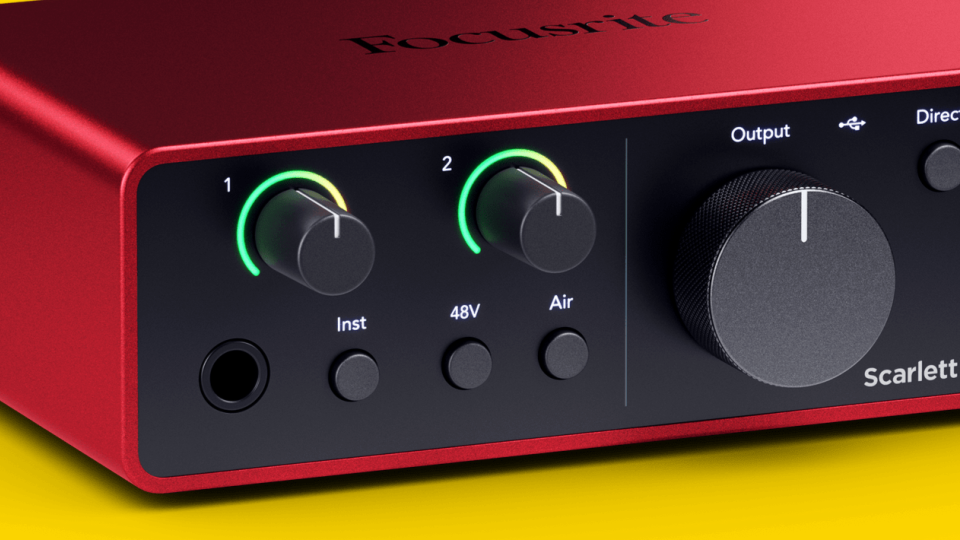
Air Modes
The 3rd generation introduced the original Air Mode. This EQ option boosts the “presence” or hi-range of a signal to help it cut through a mix.
The 4th generation interface now features two Air modes:
- Presence — This is the hi-range boost found on the 3rd gen model.
- Harmonic Drive — This new mode boosts a signal’s mid-range for more punch and body. It’s especially useful for instrumentalists, but vocalists can put it to good use too.
All in all, I’m a fan of having more options. And having two different EQ modes on the 4th Gen Scarlett gives it a serious edge over the 3rd Gen.
Bundled Software
As of this writing, both generations come with the same expansive suite of software, including Focusrite’s Hitmaker Expansion bundle.
While I’d never recommend getting an interface just for the software, it’s a nice bonus — especially if you’re relatively new to music production.
All Software Included with Focusrite Scarlett Audio Interfaces
DAWs
- Ableton Live Lite
- Pro Tools Artist (3-month subscription)
Mixing, Mastering, and Effects Plugins
- Antares Auto-Tune Access
- Brainworx Bx_console Focusrite SC
- FAST Balancer
- Red 2 & 3 Plug-in Suite
- Relab LX480
- Softube Marshall Silver Jubilee 2555
- Sonnox Vox Doubler
Virtual Instruments
- Native Instruments Massive
- XLN Audio Addictive Keys
- XLN Audio Addictive Drums 2
Subscription Services
- Landr 2-month subscription, plus 5 free masters
- Splice 3-month subscription
Is the Scarlett Solo Still a Good Interface for Beginners?
Absolutely. If all you plan to do is light recording and streaming, then either version of the Scarlett Solo is a fantastic choice.
It’s small, easy to use, and highly affordable. It’s perfect for someone’s first audio interface.
You can also check out these other beginner-friendly audio interfaces.
An incredibly robust and versatile audio interface for solo musicians and creators. The Scarlett Solo comes with 1 XLR input and 1 line/instrument input. It's small, has a rugged build, and can record audio with pristine quality.
- Rugged build quality
- Improved RedNet circuitry for hi-fidelity audio
- 2 Air Mode settings — hi-range boost and mid-range boost
- Includes software bundle
- Preamp gain could be higher
- Lacks features from other 4th gen Scarlett devices
Should You Upgrade to the Solo 4th Gen from the 3rd Gen?
If you already own a 3rd gen Scarlett Solo, I’d say stick with that or upgrade to the Scarlett 2i2.
Aside from the new Harmonic Drive Air Mode, the 4th Gen Scarlett Solo doesn’t offer significant enough improvements over the 3rd gen model to warrant an upgrade.
On top of that, it lacks some of the new features found in the 4th gen 2i2 and 4i4 models, like Auto-Gain, Clip-Safe Mode, and the external power supply.
A super-reliable audio interface that's perfect for any home studio. The 2i2 offers two inputs with built-in preamps for recording higher-quality audio. Plus, the new Auto-Gain features takes out the guesswork in setting input levels. It's the perfect, easy-to-use interface for any musician and podcaster.
- Improved gain makes some dynamic mics more usable
- 2 Air Mode settings — hi-range boost and mid-range boost
- Auto-gain and Clip Safe modes take out guesswork in setting input levels
- Rugged build quality
- Includes software bundle
- Split XLR and line inputs may confuse new users
Compare the Scarlett Solo to Other Audio Interfaces
If you want to consider other options, check out these head-to-head comparisons between the Scarlett Solo and other popular audio interfaces.
- Focusrite Scarlett 2i2 vs Scarlett Solo
- Focusrite Scarlett Solo vs Behringer U-Phoria UM2
- Focusrite Scarlett Solo vs Komplete Audio 1
Sources:
